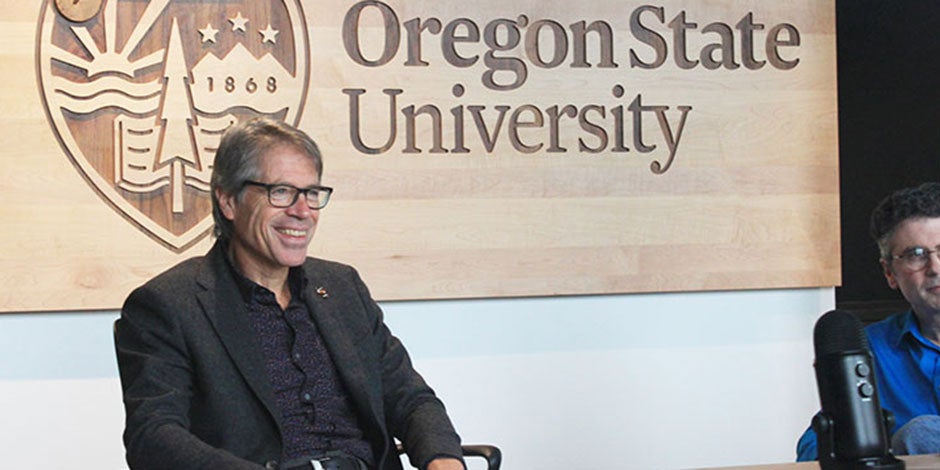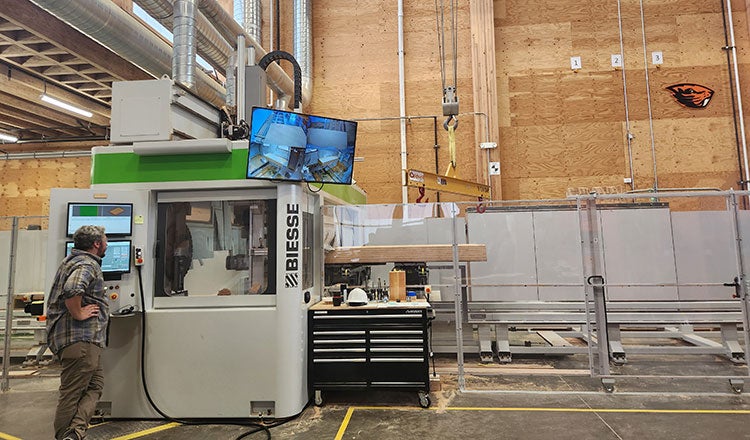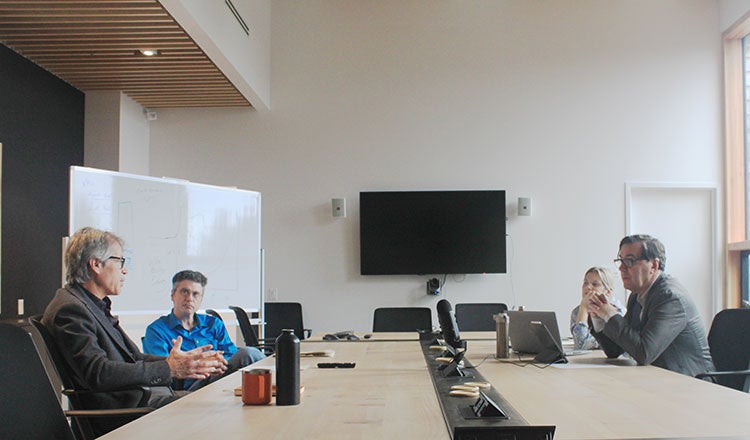
Five Insights into the Growth of Forestry
To share knowledge between our design professionals and the experts who work in the facilities we design, leaders from our education and science architecture practice travelled to Oregon State University to speak with several experts about their areas of study. Tom DeLuca is the dean of the University’s College of Forestry and an expert in forest soils, soil microbiology and biochemistry, as well as ecosystem ecology. This article highlights five key insights from our conversation, ranging from modern technology to traditional knowledge.

The Mass Timber Boom
Architects and our clients are constantly searching for ways to reduce the carbon toll and overall environmental impact of the projects we design. Mass timber’s popularity is on the rise as a more sustainable alternative to concrete and steel, for its ability to sequester carbon in the built environment and for the structure's lifetime, and the warm, biophilic property that it brings to the design. More and more building typologies are being constructed with mass timber, including hospitals and workplaces. However, some have criticized mass timber since it inherently requires cutting trees. In reality, mass timber represents a highly environmentally friendly option compared to alternatives, DeLuca explains, as mass timber products such as mass plywood panels and cross-laminated timber can be made from timber that otherwise has little value for building materials, while also supporting forest resiliency.
For example, shifts in forest policy over the last few decades have reduced timber production in the heavily forested region of the Pacific Northwest in an attempt to protect wildlife habitat and mitigate historical over-harvesting. As a result, the condition of many federal forest lands that were originally managed as plantation forests have significantly deteriorated and are at increased risk for wildfire or disease.
"With mass timber, we are able to restore resiliency to this type of forest and use the wood from thinning and restoration harvests that otherwise would become chips or slash to sustainably meet the resource and housing needs of our growing population," DeLuca said. "This helps protect our forests, while also providing usable wood, which is a renewable building material, unlike concrete or steel. It is a step in the right direction."
DeLuca said current building sustainability metrics don’t accurately consider the full environmental benefit of wood.
“In comparing mass timber to concrete or steel, many metrics don't consider that while [the wood] was growing, it created a host of ecosystem services. It provided habitat; it provided oxygen, clean water, it did all sorts of things. And the buildings made with wood products don't get credit for that. And it strikes me as, ‘Well, why not?’”
The College of Forestry is currently researching multiple approaches to determine how to sustainably balance forest resiliency, timber production and meeting human resource and housing needs. Earlier this year, the Tallwood Design Institute, housed at the College of Forestry and a partnership between the college, OSU's College of Engineering and University of Oregon's School of Design, was designated by the federal government as a "Mass Timber Tech Hub" to help advance the adoption of mass timber in the U.S.
Key Takeaways: As we continue to use mass timber in our projects, we need academia and forestry research and best practices to lead us through the challenges we face. We must prioritize using mass timber that is sustainably sourced, high-quality and part of a larger regenerative perspective of people, place and ecology.

Considering Multiple Ways of Knowing
Climate change is an existential threat to all natural systems, and forests are one of the chief examples. Modern forestry involves managing these ecosystems in a way that enhances their resilience to these threats. But this doesn’t always require coming up with new methods. Traditional Ecological Knowledge or Indigenous Knowledge are methods that have been practised by Indigenous populations and passed down through oral history for generations. Weaving principles of TEK or IK into modern forestry practices is not only about acknowledging history, but also about respectfully learning from this knowledge to create more resilient managed ecosystems. This includes the use of controlled or cultural burns like those that were once regularly carried out in the forests around the Oregon State campus to facilitate the growth of a greater percentage of mature trees.
DeLuca says Oregon State fire scientists engage with Indigenous scholars to reconstruct the fire history of the area and how that relates to understory composition, food resources and communication pathways. They also participated in running a culture camp in which students could learn from Indigenous elders and Tribal members by visiting field sites and weaving together Western science and IK.
"This work is learning how to apply this ancestral knowledge that Indigenous people have passed down for generations with Western science to create healthy forests in a changing climate," DeLuca said. “We also have a really good and collaborative faculty in terms of interdisciplinary work and working together and across disciplines.”
Key Takeaways: TEK offers insights into sustainable land management that have been honed over centuries. By combining this knowledge with modern scientific research, forestry management can develop more holistic and effective strategies for ecosystem conservation.

Bringing Tech into the Woods
Although forestry is inherently rooted in the natural world, the industry is leveraging technology in various creative ways. Forestry 4.0 refers to the digitization of the industry to enhance efficiency and sustainability in management. LiDAR technology — which uses light pulses for detection as opposed to radar’s radio waves — allows researchers to collect advanced inventory and 3D imaging of forest canopies and understory. The scans capture forests in incredible detail, including tree height, diameter and defects.
“It creates these point clouds of the forest that are a nearly perfect reproduction of the forest. It’s like you took a photograph of the forest, it’s truly amazing,” DeLuca said.
Robotics are also being used to increase harvesting efficiency. Processors scan their surroundings and update inventory as they harvest. This inventory data could be used to inform millers of the tree’s exact dimensions, defects, and point of origin, allowing them to optimize how each tree is cut for lumber. Each board has a “fingerprint” associated with the wood grain so that it can be tracked after it is shipped out. This will eventually allow builders to select their lumber supply to their exact specifications.
“The idea is the builder can say, ‘I want this kind of wood with these type of features grown under these conditions,’” DeLuca said. “Now a builder can say, ‘I know my forester,’ similarly to how we always say, ‘I know my farmer.’”
Key Takeaway: Innovative research and technology are transforming forestry management. Architects can benefit from these advancements by incorporating data-driven insights into their designs and advocating for the use of sustainable materials and practices. Knowing the innovations in lumber sourcing can also allow us and our partners to better select materials for our own needs. Architects also need to design facilities which can support this kind of high-tech research.
A New Way of Using Wood as Fuel
Wood has been used as fuel throughout history. However, forestry experts are still finding new ways to leverage this resource for fuel while contributing toward a sustainable future. Scientists are exploring ways to convert logging residues at the harvest landing.
Rather than transporting the biomass in the form of wood chips, where transportation costs quickly overtake the value of the product, small mobile units on-site convert it to biocrude — an energy-dense substance that can be transported over longer distances. This approach could make forestry biofuels a viable alternative to fossil fuels, or even crops grown for this purpose, such as corn. By utilizing what might otherwise be considered waste materials, this method addresses the issue of residue disposal, which is normally just piled and burned, while replacing grain that could be used as food.
DeLuca says many biofuels have gotten a bad reputation for many reasons, including their energy-balance given the high energy demand of farming practices, especially in grain ethanol production. “Twenty percent of national corn production is converted into ethanol, and yet the energy used in producing the fuel is almost the same as what is produced.”
This method also has broader implications for the forestry industry. By creating a market for logging residues, it could provide an additional revenue stream for forestry operations, making sustainable forestry practices more economically viable.
Key Takeaway: The use of biofuels from logging residues would improve the environmental value of a timber product. The environmental product declarations architects use for life cycle assessment would improve, in a virtuous cycle.
Digging into Soil Carbon
Soil is an often-overlooked factor in a forest’s carbon equation but plays a key role in its overall resilience. “There’s more carbon stored in the soils than all the forests combined on earth,” DeLuca said. “There’s three to four times more carbon stored in soils than in the overstory of all the rainforests. So, nature has stocked away a gob of carbon in the soil.”
Workers in the forestry industry need to be careful not to disturb the soil too much during harvesting. However, research has shown that mineral soil carbon remains relatively stable over long periods despite this activity.
“Soils are a living entity. The sand and silt are like the skeleton; the clay and the organic matter are like connective tissue that creates the unique architecture of soil; then you have the digestive and respiratory systems — the microbial community. It's breathing and it only can live when it has its symbiotic partner, which is the plant community,” DeLuca said.
Sustainable forestry and agriculture require steady management of this carbon level and maintenance of microbial and mycorrhizal networks — which are devastated with some methods. Forestry is surprisingly gentle on soils, in that there is no tillage and soils remain under plant cover for rotation lengths measured in decades, as opposed to annual tillage in agriculture. Wildfire and prescribed fire generate pyrogenic carbon, or charcoal, which represents part of the soil’s long-term carbon storage capabilities and overall health. Pyrogenic carbon is produced through natural and controlled burns and can remain in the soil for hundreds and even thousands of years, contributing to soil productivity. Sustainable forestry practices combined with reintroduction of fire can further enhance soil carbon storage and overall forest health.
Key Takeaway: Soil plays a crucial role in forest carbon sequestration, with mineral soil carbon remaining stable even after timber harvesting. Pyrogenic carbon, produced through natural and controlled burns, contributes to long-term soil fertility and carbon storage. Sustainable forestry practices, such as variable retention harvesting, enhance soil carbon storage and overall forest health. Architects can use this knowledge to select sustainable materials, and design buildings, and sites, on “living soil.”



